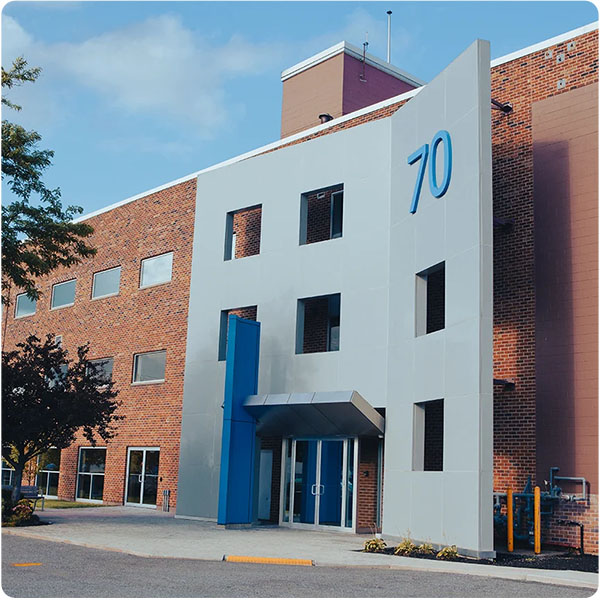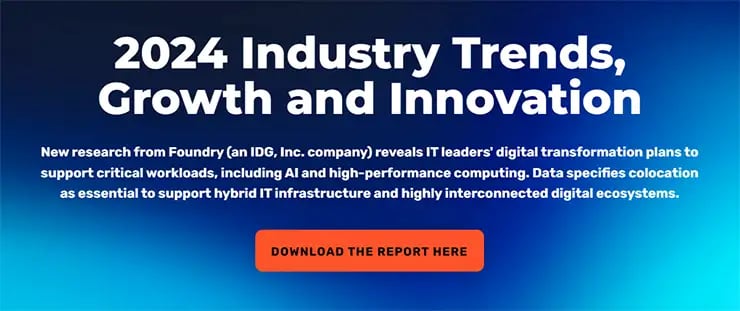
Colocation: A Sustainable Data Center Alternative
As companies focus more on sustainability and strive to reduce their carbon footprint, the data center has become a focal point – and colocation presents a compelling solution.
This blog is the second in a two-part series exploring sustainable alternatives to on-premises data centers. In the first blog, I covered cloud sustainability. In this second blog, I will show how data center colocation presents a more sustainable option than operating an-on premises data center.

The Growing Challenge of Data Center Sustainability
The explosion of digital technology has driven a continuous rise in energy consumption and resulting greenhouse gas emissions as data centers around the world process an increasing deluge of data. Sustainability consistently remains a top 10 business priority in 2024, surpassing even productivity and efficiency this year, according to analyst firm Gartner.1
Data centers are essential to business, but we must address the fact that they generate substantial carbon emissions. The U.S. Office of Energy Efficiency and Renewable Energy says data centers are one of the most energy-intensive building types, consuming 10 to 50 times the energy per floor space of a typical commercial office building.2 And data center energy consumption continues to increase due to emerging technologies such as artificial intelligence (AI), cryptocurrency and blockchain.
“Data centers consume a tremendous amount of energy because they generate heat, which requires cooling services,” explains Ram Ramesh, Ph.D., professor of management science and systems, University at Buffalo School of Management. “The rise in energy costs coupled with the urgent need to reduce the carbon footprint together create an imperative for new approaches to achieve efficiency.”3
Experts estimate that data centers account for around 1%-3% of the world’s carbon emissions. For this reason, data center sustainability is becoming a critical mission for companies. Gartner reports that 75% of organizations will implement a data center infrastructure sustainability program by 2027, a notable increase from less than 5% in 2022.4 However, as data volumes, rack densities and power requirements of data centers continue to grow – driven by AI and other power-hungry technologies – sustainability becomes progressively challenging for organizations operating on-premises data centers.
Colocation Delivers a Sustainability Advantage
One effective way to meet your data center sustainability goals is to utilize colocation services from CoreSite. “Our approach to sustainability is centered around being more energy efficient, reducing our carbon footprint and helping customers reach their sustainability requirements,” Juan Font, President and CEO of CoreSite and SVP of American Tower confirms.5
The following are several ways colocation delivers a sustainability advantage over on-premises data centers:
Shared resources: One of the top sustainability benefits of colocation is the efficiency gained from combining data from different customers into one state-of-the-art facility. “Merging multiple data centers into a smaller number of larger facilities helps reduce energy consumption and overall carbon emissions,” advises IT asset management vendor Device42.6
Commitment to sustainability: A colocation provider should be totally committed to sustainability. CoreSite demonstrates this commitment by building energy-efficiency into all new data center construction projects, constantly evaluating equipment options and designs, improving air flow, and carefully monitoring and improving the energy efficiency of colocation facilities. CoreSite further strengthens its sustainability efforts by joining the Infrastructure Masons Climate Accord (ICA; iMasons), a historic cooperative of more than 150 companies dedicated to reducing carbon in digital infrastructure. This level of commitment goes beyond corporate interests to benefit customers and the world community.
Resource management: Colocation providers use data center infrastructure management (DCIM) and other monitoring tools to track and optimize resources and ensure energy efficiency.
Energy-efficient cooling: Cooling is a major energy consumer in a data center, and colocation providers can offer innovative cooling techniques and technologies to reduce power usage and carbon emissions – leading-edge capabilities that would be cost-prohibitive to implement in most on-premises data centers.
For example, CoreSite’s Boston data center (BO1) features an energy-efficient cooling system designed for sustainability, saving eight million kilowatt-hours annually. In addition, CoreSite employs free cooling at several colocation campuses, using outside air to cool the facility up to 60% of the time, thereby reducing energy consumption and emissions.
Colocation providers like CoreSite also use liquid cooling to improve energy efficiency and sustainability. Liquid cooling only requires 20% of the energy used by air-cooled data centers and has the added sustainability advantage of using less water than conventional air cooling.7
Renewable energy certificates (RECs): CoreSite offers RECs to customers at all its data centers. RECs are the accepted legal instrument used to substantiate renewable electricity use claims in the United States. Each REC equals one megawatt-hour (MWh) of electricity that is generated by a renewable energy resource and delivered to the power grid. RECs are scalable by 1000 kWh (1MWh) increments to most volumes and term lengths, making this an ideal option for small- and medium-sized businesses.
Cloud interconnections: CoreSite colocation data centers provide the added advantage of direct cloud connections, enabling customers to leverage the sustainability edge offered by the cloud. Read Part 1 of this blog series to find out more about cloud sustainability.
Meeting Your Sustainability Goals with Colocation
Sustainability is a shared responsibility, so look for a colocation provider that empowers you to meet your sustainability objectives. For example, CoreSite provides access to real-time metrics so you can track your sustainability performance. CoreINSITE®, a data center intelligence solution within the MyCoreSite customer service delivery platform, supplies relevant sustainability KPIs including carbon footprint, power usage, environmental conditions, and historical as well as near real-time performance data.
Know More
Schedule a meeting with CoreSite today to find out more about how colocation can support your sustainability initiative and make a real difference for the environment. And, as you are researching sustainability solutions, read Part 1 of this blog series to find out more about cloud sustainability.
References
-
Gartner Survey Reveals 69% of CEOs View Sustainability as a Growth Opportunity, Gartner, Inc., June 6, 2024
-
Data Centers and Servers, U.S. Office of Energy Efficiency and Renewable Energy
-
Reducing the carbon footprint of data centers, University at Buffalo, March 8, 2023
-
Gartner Predicts 75% of Organizations Will Have Implemented a Data Center Infrastructure Sustainability Program by 2027, Gartner, Inc., May 2, 2023
-
Looking Ahead: Growth, Sustainability and 5G in 2023, Connect[ED] Blog, CoreSite
-
Data Center Carbon Footprint: Concepts and Metrics, Device42
-
Solving Tomorrow’s Cooling Challenges with Liquid Cooling, Connect[ED] Blog, CoreSite








